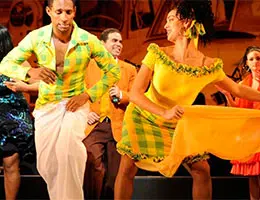 Mambo is a genre of music and dance that emerged in Cuban territory. The term has Antillean origins, although its roots must be traced back to African languages.
Mambo is a genre of music and dance that emerged in Cuban territory. The term has Antillean origins, although its roots must be traced back to African languages.
Born from the combination of elements of son and danzón , Antonio Arcaño and Orestes López are considered to be the pioneers of mambo, while Dámaso Pérez Prado devised the dance . Over the years, the popularity of mambo grew in Cuba and later reached other countries, such as the United States and Mexico .
At a general level, mambo combines features of African music with jazz and various Latin American rhythms. Each measure includes a period of silence, which corresponds to the pause that the dancers make to highlight the syncopation.
The aforementioned Pérez Prado , born in 1917 and died in 1989 , is known as “The King of Mambo” for the dissemination he gave to the genre worldwide. The song “Mambo Nº 5” was one of his main hits: the song even had a very famous version performed by Lou Bega in 1999 . Tito Puente ( 1923 – 2000 ) is another of the musicians who stand out for his contributions to the mambo.
The case of Mambo Nº 5 is not unusual in terms of the name, since in the past it was very common to name pieces of this genre with a cardinal number. On the other hand, it was also customary to baptize them with women's names, as is the case with the well-known Patricia and Roberta .
Regarding the dance itself, it must be danced as a couple and its choreography stands out for being difficult and strong. Synchronization between the two dancers and coordination of movements is essential, especially given the high speed at which they must be performed. Another necessary aspect to master the mambo is agility, a factor that can make the difference between a beginner and a professional capable of dazzling their audience.
As mentioned above, the rhythm of the mambo is syncopated . This means that the accentuation of the notes of the melody does not always coincide with the basic structure of the beat: syncopation allows weak or semi-strong notes to be accentuated, as well as including silences to give rise to the so-called backbeat .
The mambo beats have a period of silence in which the dancers must pause. This takes place in the fourth quarter. During the basic rhythm, one leg should be left bent while the other is extended, brought forward or to the side.
 The strength of the mambo movements give it a very particular identity that is associated with its African roots. It is a combination of considerable flexion of the joints with highly accentuated expressiveness.
The strength of the mambo movements give it a very particular identity that is associated with its African roots. It is a combination of considerable flexion of the joints with highly accentuated expressiveness.
Throughout their evolution, mambo dancers developed three well-defined types: the single, the double and the triple. The latter gave rise to the birth of chachachá , a dance that is well known even today, especially in Latin America.
Just like other Latin American dances, many people allow themselves to be conquered by its steps and music and decide to take classes despite not having great natural aptitudes. The benefits of learning to dance are many, both physically, emotionally and culturally , as it keeps us in shape, helps us release stress and allows us to make new friends.
In Argentina , on the other hand, mambo is a lunfardo term that refers to a mess , a confusion or a conflict . For example: “I'm with a barbaric mambo at work,” “I have a lot of mambos in my head and I don't know what to do,” “Cut it out with the mambo and come home tonight so we can eat some pizzas and chat for a while.”
